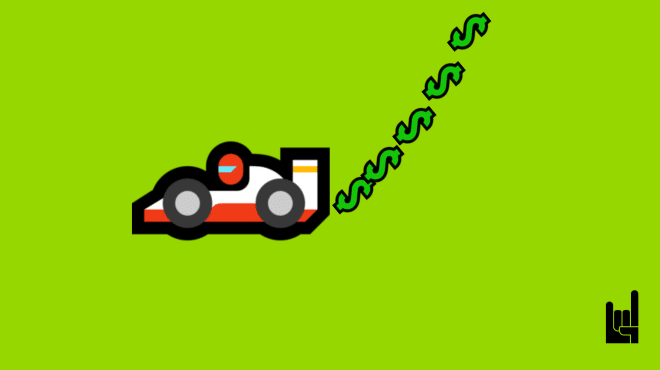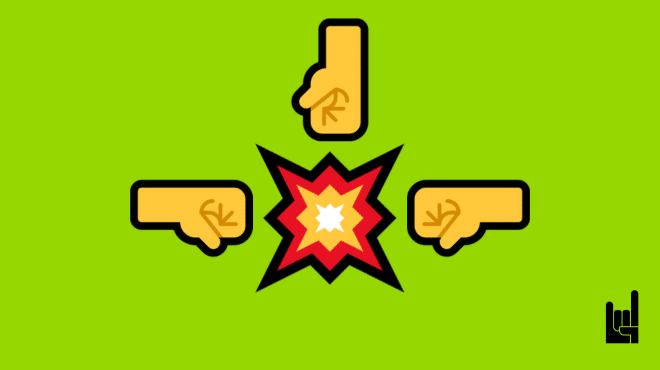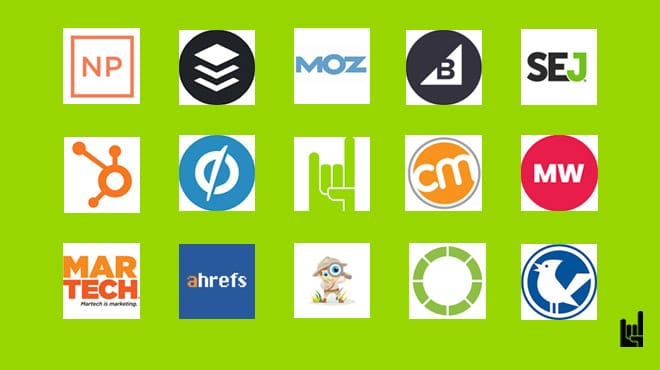The Tangram metaphor
In this article we use “tangram”, a traditional Chinese puzzle that involves arranging seven geometric pieces (called “tans”) to form various shapes. The puzzle helps with problem-solving, spatial reasoning, and geometric skills but we also use it to illustrate in a very memorable way, marketing concepts that work as one to illustrate the holistic approach. Enjoy the “airplane” tangram.
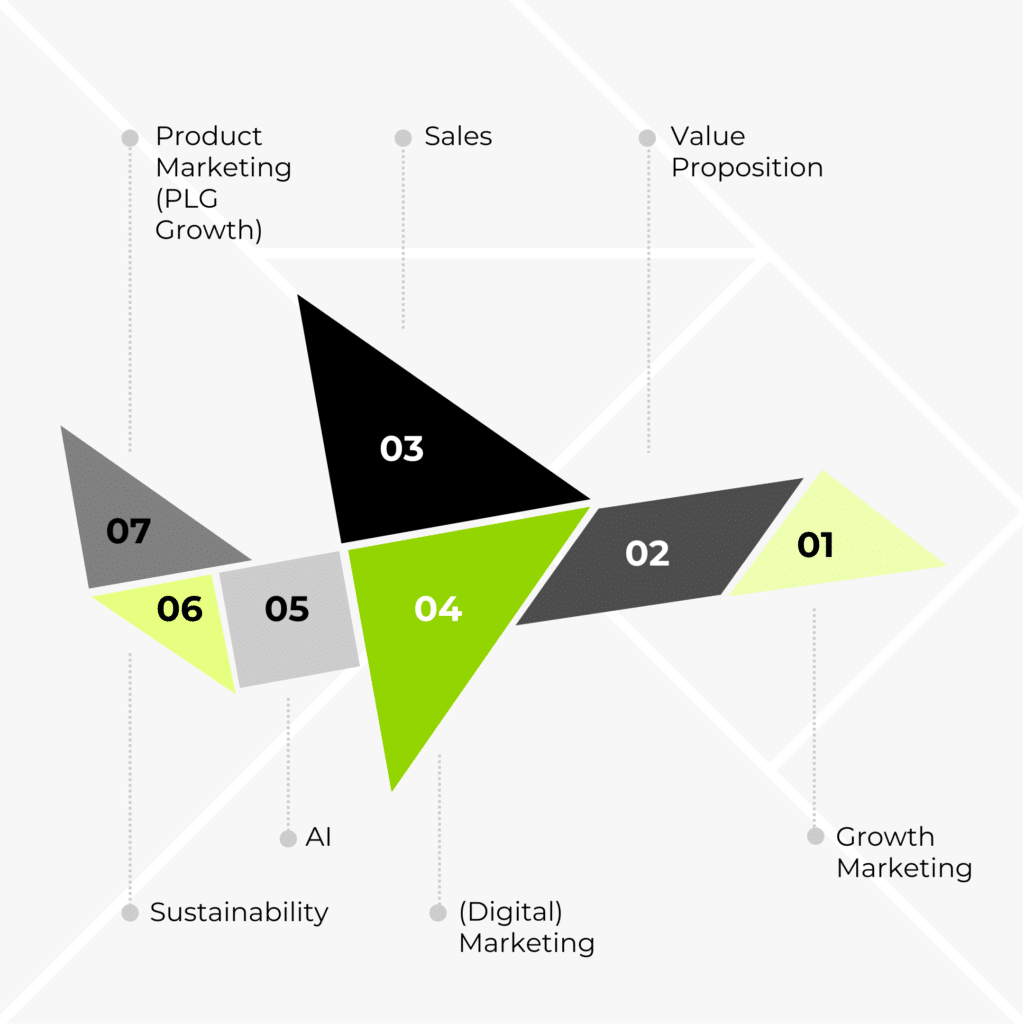
The 7 Marketing Disciplines
As per our view and experience working with companies of all sizes and stages, the most successful companies no longer operate within silos. The days of separate, disconnected marketing, sales, and product development strategies are long gone. Instead, forward-thinking companies approach growth with an interconnected mindset, weaving together the core elements of growth hacking, value proposition refinement, sales mastery, digital marketing, AI integration, sustainability, and product-led growth (PLG). However, to truly unlock the potential of these strategies, one must deep dive into each of them, upskilling him/herself and understanding their deeper, symbiotic relationships—a perspective only years of experience and a broad, holistic view can reveal.
1. Growth Hacking Fuels Innovation, but It’s Not Enough Without Stability
Growth hacking is often seen as a quick, agile way to skyrocket a company’s growth through creative experimentation. However, growth hacking can quickly lead to chaos without solid foundations—such as a crystal-clear value proposition and streamlined sales processes. It’s akin to building a skyscraper on quicksand; growth might be fast initially, but that momentum can collapse without strategic underpinnings. Companies need to balance the skill of growth hacking with the precision of sales, value articulation, and AI-powered analytics to make sustainable progress. Experienced marketers understand that while growth hacking opens the door, consistency in execution is what locks in long-term success.
Growth hacking is not just about immediate wins; it’s a long-term survival strategy. It trains your organization to think differently, continually optimize, and become adaptive—a skill that’s becoming as important as the product or service itself. You’re not just building growth; you’re building organizational resilience.’’
2. A Refined Value Proposition Is Your North Star
For decades, marketers have known that a company’s value proposition is more than just a tagline—it’s the very foundation of why customers choose your product over a competitor’s. An expert with 20+ years of experience knows that everything starts here. You can have the best digital marketing campaign or the most advanced AI-powered sales system, but if your value proposition isn’t clear, compelling, and customer-centric, your efforts will flounder.
A well-defined value proposition not only guides sales strategies but also acts as a beacon for product-led growth efforts, aligning every touchpoint with the customer journey. This is why sustainability can drastically elevate your brand when incorporated into your value proposition. As the world moves toward more ethical consumption, integrating sustainability into the heart of your offering transforms it from a “nice-to-have” to a powerful differentiator. Only a seasoned marketer understands how to build value propositions that speak to deeper customer desires, connecting emotionally, logically, and ethically.
Refine your value proposition—explore workshops focused on perfecting your pitch and positioning.
Your value proposition isn’t just what you tell your customers—it’s how they feel about choosing you. In 2024, an effective value proposition doesn’t just answer “why us?” but also “why now?” and “why us forever?”. It needs to articulate not only short-term wins but long-term loyalty. It also has to speak to their values—whether that’s through sustainability, innovation, or trust—because that’s the heart of what drives loyalty in today’s customers.’’
3. Sales Is No Longer a Transaction—It’s a Data-Driven Dialogue
In a hyper-connected digital era, sales is no longer just about closing deals—it’s about creating meaningful, data-driven dialogues that build long-term relationships. The days of cold calls and generic pitches are fading. Modern sales teams now rely on AI-driven insights to understand customer behaviors, preferences, and pain points in real-time.
An experienced marketer understands that integrating AI with sales isn’t just about automation; it’s about personalization at scale. This convergence allows companies to deliver targeted solutions, not just products, driving higher engagement and conversion rates. More importantly, the AI-driven approach makes sales more aligned with marketing, ensuring that leads generated through digital marketing campaigns are hyper-qualified by the time they reach the sales team. The result? Seamless customer experiences where marketing, product, and sales work in perfect harmony.
Enhance your sales game—check out these list on expert-led B2B sales workshops we compiled.
The best sales teams will use AI not only to predict customer needs but to surprise and delight them. Imagine AI identifying subtle behavioral shifts and signaling to a human rep when a personal touchpoint is needed—whether it’s a handwritten note, a tailored offer, or a well-timed phone call. In 2024, sales will be about knowing when to go digital and when to go human—a nuanced skill that only those truly skilled in both areas will master.’’
4. Digital Marketing Is Evolving, But Storytelling Still Reigns Supreme
As digital marketing becomes more algorithm-driven, powered by AI and automation, it’s easy to forget the importance of human connection. Despite technological advancements, the essence of marketing remains the same: storytelling. A true expert in marketing recognizes that no matter how much we rely on data, algorithms, and automation tools, humans still connect with stories, emotions, and narratives.
Great digital marketing leverages data to tell compelling stories that connect with the right audience at the right time. But without a compelling value proposition at the center of that story—and without AI helping to deliver that story to the right audience at the right time—campaigns fall flat. Experts also understand the need for sustainability in storytelling. Brands today must communicate their commitment to a sustainable future, embedding environmental and social responsibility into their digital marketing narratives, which resonates deeply with the conscious consumer of 2024.
In 2024, digital marketing needs to move beyond merely reaching your audience—it must now anticipate their needs before they even realize they have them. Digital marketing that makes customers feel understood on both a practical and emotional level will win.
5. Artificial Intelligence Is More Than a Tool—It’s an Accelerant
There’s no denying that AI is reshaping the way businesses operate. But what distinguishes an expert from a novice is the understanding that AI is not merely a tool to automate repetitive tasks—it’s an accelerant that amplifies everything a company does well. AI can enhance sales by providing predictive analytics, improving lead scoring, and personalizing customer interactions at scale. In digital marketing, it enables real-time campaign optimization and deeper audience segmentation.
But the secret sauce is AI’s ability to turbocharge growth hacking. Experienced marketers see AI as the ultimate experimenter, allowing them to A/B test at a scale and speed that was previously unimaginable. Whether it’s testing various landing pages, different messaging, or identifying patterns in customer behavior, AI empowers marketers to iterate rapidly, fail fast, and scale successes in real-time.
Ready to integrate AI into your business strategy? Discover more AI-focused workshops in our dedicated guide.
The businesses that succeed in 2024 will use AI not to make decisions for them but to supercharge creativity, strategy, and timing.
6. Sustainability: The Competitive Advantage of the Future
While sustainability used to be a secondary consideration for businesses, it’s now becoming a competitive advantage. For companies that want to stand out, integrating sustainability into every facet of their operations is essential. But sustainability is more than just green practices—it’s about building trust with consumers, employees, and investors alike.
A well-seasoned marketer knows that consumers in 2024 are not only buying products—they’re buying into brands that reflect their values. Companies that prioritize sustainability and demonstrate ethical practices throughout their product lifecycle, from sourcing to post-consumer recycling, are well-positioned to win over modern, conscientious buyers. When combined with product-led growth strategies and communicated through digital marketing, sustainability doesn’t just elevate your brand—it becomes a key selling point.
Sustainability isn’t just about reducing harm—it’s about creating positive impact. The companies that will thrive are those that find ways to turn sustainability into a value-add, rather than a checkbox. Your brand isn’t just offering a solution—it’s solving a bigger problem.’’
7. Product-Led Growth: The Ultimate Alignment starts from within
The beauty of product-led growth (PLG) is that it brings together all the other disciplines in a powerful, synergistic way. A product-driven approach means the product is the primary driver of customer acquisition, retention, and expansion. But this doesn’t work in isolation—it needs a robust value proposition to communicate its uniqueness, digital marketing to generate awareness, and growth hacking to experiment with scaling quickly.
For PLG to succeed, the product itself must provide undeniable value, often demonstrated through AI-powered insights that personalize the user experience and guide product development. Additionally, as businesses grow more attuned to sustainability, ensuring that your product not only serves users but also contributes to the planet’s well-being becomes a vital part of the PLG strategy.
Take your product marketing to the next level—explore these hands-on workshops designed to drive product-led growth.
The most successful companies in 2024 won’t just rely on PLG to generate leads—they’ll turn their best customers into co-marketers. By designing a product experience so irresistible that users naturally share it, you transform your user base into an organic marketing force’’.
The Takeaway: A Masterful Interconnection
The master marketer understands that each of these seven disciplines—growth hacking, value proposition, sales, digital marketing, AI, sustainability, and product-led growth—is deeply interconnected. Success in one area often depends on how well you’ve executed in others. It’s this integrated approach that will enable businesses in 2024 and beyond to not only survive but thrive in a complex, rapidly evolving marketplace.
In the next section, we’ll explore how to tap into the power of these interconnections and why each of these elements is critical for the future of your business.
Mastering the 7 Key Disciplines to Propel Your Business Forward
Understanding the interconnectedness of growth hacking, value proposition, sales, digital marketing, AI, sustainability, and product-led growth (PLG) is one thing—but how do you put that knowledge into action? The secret lies not just in mastering each field independently, but in knowing how to leverage them together in ways that amplify your results. This section dives deep into how to creatively apply these seven disciplines to create exponential growth in your business.
1. Growth Hacking: Prioritize Experiments that Feed into the Bigger Picture
Growth hacking is all about rapid experimentation, but to truly make a lasting impact, you need to focus on experiments that align with your overall strategy. Here’s where out-of-the-box thinking comes in: imagine using AI to run multiple A/B tests across various audience segments simultaneously, collecting data not just on conversions, but on how each segment responds emotionally to different messages. Growth hacking powered by AI-driven insights will allow you to iterate faster and create more personalized user experiences—feeding right back into your digital marketing campaigns.
Out-of-the-box tip: Don’t just experiment on marketing channels—test your value proposition as well. Run multiple value propositions for the same product in parallel across different platforms. This way, you’re optimizing not only for acquisition but also for how potential customers perceive your product’s core value. The value proposition that resonates most with your ideal audience can then be the anchor for your marketing and sales strategy.
Unlock the secrets of fast growth by diving into the top growth hacking course available in 2024
2. Value Proposition: Align Your Product with the Sustainability Narrative
In 2024, a value proposition centered around environmental impact is no longer just an option—it’s a necessity. Consumers are more educated and skeptical about greenwashing, so your value proposition must reflect genuine efforts in sustainability. But the key is to connect sustainability to the product’s functionality in a way that is both authentic and advantageous to the consumer.
Out-of-the-box tip: Go beyond the usual “eco-friendly” claims by focusing on how sustainability makes the product better. For example, if you offer a software product, highlight how your cloud infrastructure is optimized to reduce energy consumption and how that translates into cost savings for users. If you’re in the retail sector, show how using sustainable materials enhances product durability and leads to a better user experience. This positions sustainability not just as a moral choice, but as a strategic advantage in your value proposition.
3. Sales: Use AI to Predict and Personalize Sales Journeys
The future of sales isn’t just about understanding the customer’s needs—it’s about anticipating them. AI can transform how sales teams operate by providing predictive analytics that forecast customer behavior based on data from past interactions. Imagine knowing exactly when a lead is about to make a decision based on subtle behavioral patterns that AI detects in real time. This allows your sales team to proactively engage at the most opportune moments.
Out-of-the-box tip: Personalize the entire sales journey using AI. Rather than generic follow-up emails, sales teams can use AI to craft hyper-relevant messages that address specific customer pain points before the customer even brings them up. Moreover, AI-driven segmentation can ensure that leads are nurtured with content tailored specifically to their unique journey, creating an omnichannel experience that feels personalized from the first touchpoint to the final sale.
4. Digital Marketing: Leverage Sustainability as Your Lead Magnet
Sustainability is not just a corporate responsibility—it’s a marketing asset. Today’s customers are actively looking for brands that align with their values, and sustainability is a significant driver of purchasing decisions. Instead of merely using digital marketing to showcase your product features, use sustainability as the foundation of your campaigns to attract a loyal customer base that shares your vision.
Out-of-the-box tip: Build a sustainability-driven content strategy that educates your audience. Create engaging content—such as blog posts, videos, and infographics—that explains how adopting sustainable practices improves not only the environment but also their lives. Position your brand as a thought leader in sustainability, and leverage this content to nurture leads at every stage of the funnel. Bonus: Use AI tools to personalize sustainability messages based on user behavior to increase relevance and engagement.
5. AI: Don’t Just Automate—Augment Human Intelligence
AI’s potential goes beyond automating mundane tasks. What if instead of replacing human decision-making, you use AI to supercharge human intuition? In marketing, AI can analyze vast amounts of data to predict customer behavior, but the real magic happens when it augments human creativity and strategy. Marketers with deep experience can leverage AI insights to make strategic decisions faster, without losing the human touch.
Out-of-the-box tip: Use AI as a creativity amplifier by incorporating AI-driven tools into your brainstorming sessions. For example, AI can identify content or product ideas based on emerging trends before they’ve become mainstream. Integrate AI into your content creation workflow, using it not only to identify patterns in audience behavior but also to suggest new campaign ideas you might not have considered.
6. Sustainability: Integrate Circular Economy Practices
Sustainability workshops focus heavily on minimizing environmental impact, but the true game-changer is the circular economy—a system where products are designed with their entire lifecycle in mind. This can reduce waste and unlock new revenue streams, as businesses find innovative ways to reuse, recycle, or repurpose products after their initial life cycle.
Out-of-the-box tip: For companies producing physical products, consider introducing buy-back or trade-in programs where customers return used products for a discount on new ones. This can create a loyal customer base while supporting sustainability efforts. For service-based industries, explore the digital circular economy by offering software products with upgradeable features that extend the product lifecycle, reducing waste and fostering longer-term customer relationships.
Here is a list of all the best sustainability courses we selected. We attended a few of them 🙂
7. Product-Led Growth (PLG): Let Users Be Your Marketers
In a product-led growth strategy, your product is both the marketing and sales tool. But an expert knows that PLG doesn’t just happen—it’s carefully orchestrated by creating a frictionless user experience that encourages viral growth. However, PLG isn’t limited to features and functionality; it extends to sustainability and ethical branding. Today’s users want more than a great product—they want a brand they can believe in.
Out-of-the-box tip: Embed gamification into your product experience that encourages users to not only engage more deeply but also share their experiences with others. Create referral loops where users are rewarded for recommending the product to others, and tie these rewards into sustainable causes. For instance, for every referral, plant a tree or contribute to environmental restoration efforts. This seamlessly connects PLG with your brand’s sustainability values, turning users into brand advocates.
How to Take Action
These aren’t just theories—they’re actionable strategies to align your business operations with the rapidly evolving demands of today’s marketplace. To truly skyrocket your company’s performance, it’s essential to integrate these disciplines into a cohesive strategy that amplifies the impact of each area. By leveraging the power of growth hacking, a strong value proposition, AI-driven sales and marketing, sustainability practices, and product-led growth, your business will not only stay relevant but thrive in 2024.
Stay ahead of the digital curve—click through to explore workshops that will sharpen your digital marketing skills and help you optimise your strategy.
Why an Integrated Approach is the Ultimate Growth Engine
True success doesn’t come from excelling in isolated functions—it comes from weaving growth hacking, value proposition development, sales, digital marketing, AI, sustainability, and product-led growth (PLG) into a single, cohesive strategy. These disciplines are not standalone pillars, but rather dynamic forces that, when combined, create exponential results. The real power lies in synergy—the way these elements interact to amplify one another. Here’s why a unified approach is not just beneficial, but essential for business success in 2024 and beyond.
1. The Growth Engine: Fueling Experimentation with Purpose
At the core of this integrated strategy is growth hacking, a methodology rooted in fast experimentation. However, growth hacking in isolation is directionless. The experiments conducted must serve a greater purpose, and that’s where the value proposition comes into play. Your value proposition guides what you’re optimizing for. It’s not just about testing tactics; it’s about continuously refining the core narrative that resonates with your audience.
Why the synergy matters: Imagine running growth experiments without a strong value proposition—those experiments would simply be a collection of isolated tactics, providing little insight into customer preferences. But when you embed a clear, compelling value proposition into your growth hacking efforts, every test becomes a means to fine-tune that message. As AI analyzes data from these experiments, it provides predictive insights that further sharpen your value proposition, ensuring your growth efforts are both agile and aligned.
2. The Data Loop: AI, Sales, and Digital Marketing in Harmony
When AI, sales, and digital marketing are integrated, they create a powerful feedback loop that continually optimizes performance. AI doesn’t just automate tasks—it becomes the engine that collects and interprets data from both sales and marketing efforts, feeding insights back into those very processes. Digital marketing campaigns generate leads, AI analyzes their behavior, and sales teams then use this data to personalize the customer journey. But this loop doesn’t stop there—successful sales interactions provide even more data for AI to process, leading to smarter marketing campaigns.
Why the synergy matters: This integration allows for hyper-personalization at scale, with AI acting as the connective tissue between digital marketing and sales. AI doesn’t replace the human element in sales; it enhances it by providing sales teams with predictive insights about customer intent. This means that marketing campaigns don’t just drive traffic—they set the stage for salespeople to engage at precisely the right moment, creating a seamless handoff between marketing and sales.
3. Amplifying Growth with Product-Led Experiences and Value-Driven Messaging
Product-Led Growth (PLG) can’t function in a vacuum. To truly succeed with PLG, the product experience needs to be deeply aligned with the value proposition and amplified through digital marketing efforts. Think of it like this: the product sells itself through its experience, but to bring users in the door, the product needs to communicate its core value effectively. Here’s where the value proposition and growth hacking come into play—these elements serve as entry points, while PLG ensures that the experience lives up to the promise.
Why the synergy matters: PLG is driven by the product’s ability to deliver on the value proposition at every touchpoint. The user experience needs to reinforce the brand’s message, and that message needs to resonate with a broader audience via digital marketing. Growth hacking experiments, meanwhile, help identify which parts of the product experience should be emphasized in marketing, creating a feedback loop where product improvements inform marketing, and marketing drives product adoption.
4. Sustainability: The Ultimate Trust Builder in the PLG Cycle
Sustainability isn’t just a corporate responsibility—it’s a critical piece of your overall growth engine. Customers today expect brands to contribute to environmental well-being, and sustainability provides an unparalleled opportunity to build trust. But here’s the twist: sustainability initiatives need to be integrated into your product experience and communicated clearly through your value proposition.
Why the synergy matters: In a PLG model, where the product is the primary driver of growth, sustainable features can differentiate your product in the marketplace. AI can help you analyze customer data to see how sustainability influences their behavior, feeding this information back into sales and marketing strategies. Digital marketing can then amplify those sustainability efforts, while growth hacking tests which sustainability narratives resonate most with your audience. Ultimately, sustainability becomes a self-reinforcing growth lever, as customers who value ethical business practices become advocates for your brand, driving organic growth.
5. Value Proposition and Sales: The Trust Bridge
A compelling value proposition sets the stage, but it’s the sales team that delivers on that promise. The relationship between value proposition and sales is symbiotic—sales teams must embody the brand’s promise, while feedback from sales interactions refines the value proposition over time. AI helps sales teams focus on leads who are more likely to convert, while digital marketing builds the foundation of awareness and trust.
Why the synergy matters: In this interconnected system, your sales team becomes the ultimate brand ambassador, translating the theoretical promise of the value proposition into a real-world, human experience. Every sale made based on a value-aligned approach reinforces the brand’s message, turning sales from a one-time transaction into a relationship-building exercise that feeds back into your long-term growth strategy.
6. AI-Powered Experimentation and Optimization: A Self-Improving System
When you integrate AI into this multi-disciplinary system, you don’t just get insights—you get a self-improving system. AI doesn’t simply tell you what worked; it helps predict what will work next, guiding growth hacking efforts, refining value propositions, and optimizing both sales strategies and digital marketing campaigns. This constant feedback loop of AI-driven insights across multiple disciplines ensures that your business isn’t just responding to changes—it’s anticipating them.
Why the synergy matters: AI is the force multiplier for everything—growth hacking becomes smarter, sales become more personalized, and sustainability efforts can be tracked and optimized in real time. This turns your entire business strategy into a dynamic, ever-evolving system that constantly adjusts based on data, rather than operating on outdated assumptions or guesswork. The more data your business generates, the smarter your overall system becomes, continuously elevating each of the seven disciplines.
7. The Customer Journey as the Unifying Force
At the heart of this integrated system is one consistent element: the customer journey. Every single discipline we’ve discussed ultimately ties back to this. Whether through growth hacking, sales, or digital marketing, each tactic must be aligned to guide the customer through an experience that feels cohesive, personal, and—most importantly—valuable.
Why the synergy matters: The customer’s journey doesn’t happen in stages; it happens in a fluid, dynamic way. They may discover your product through growth hacking efforts, engage with your brand through digital marketing, be convinced by a value-driven sales call, or find satisfaction in your PLG strategy. AI ties it all together, ensuring that the journey feels intuitive, while sustainability initiatives build long-term trust. Businesses that see the customer journey as the common thread connecting these disciplines will create seamless experiences that drive loyalty, advocacy, and exponential growth.
The Power of Integration
‘’The reason why mastering these seven disciplines is essential for future-proofing your business lies in the interplay between them. Growth hacking feeds into value proposition refinement, which drives sales strategy and digital marketing. AI serves as the optimization engine, while sustainability weaves throughout, creating trust and loyalty. And all of this comes together in the product-led growth model, where the product becomes not just a tool but an experience that exemplifies the entire strategy.’’
Together, these disciplines create a self-reinforcing growth loop that’s greater than the sum of its parts. The more integrated your approach, the more adaptable and resilient your business becomes, ensuring that you not only survive but thrive in a rapidly changing world. In the final section we’ll present curated lists of courses and workshops that will help you master these crucial strategies.
Was this article useful?
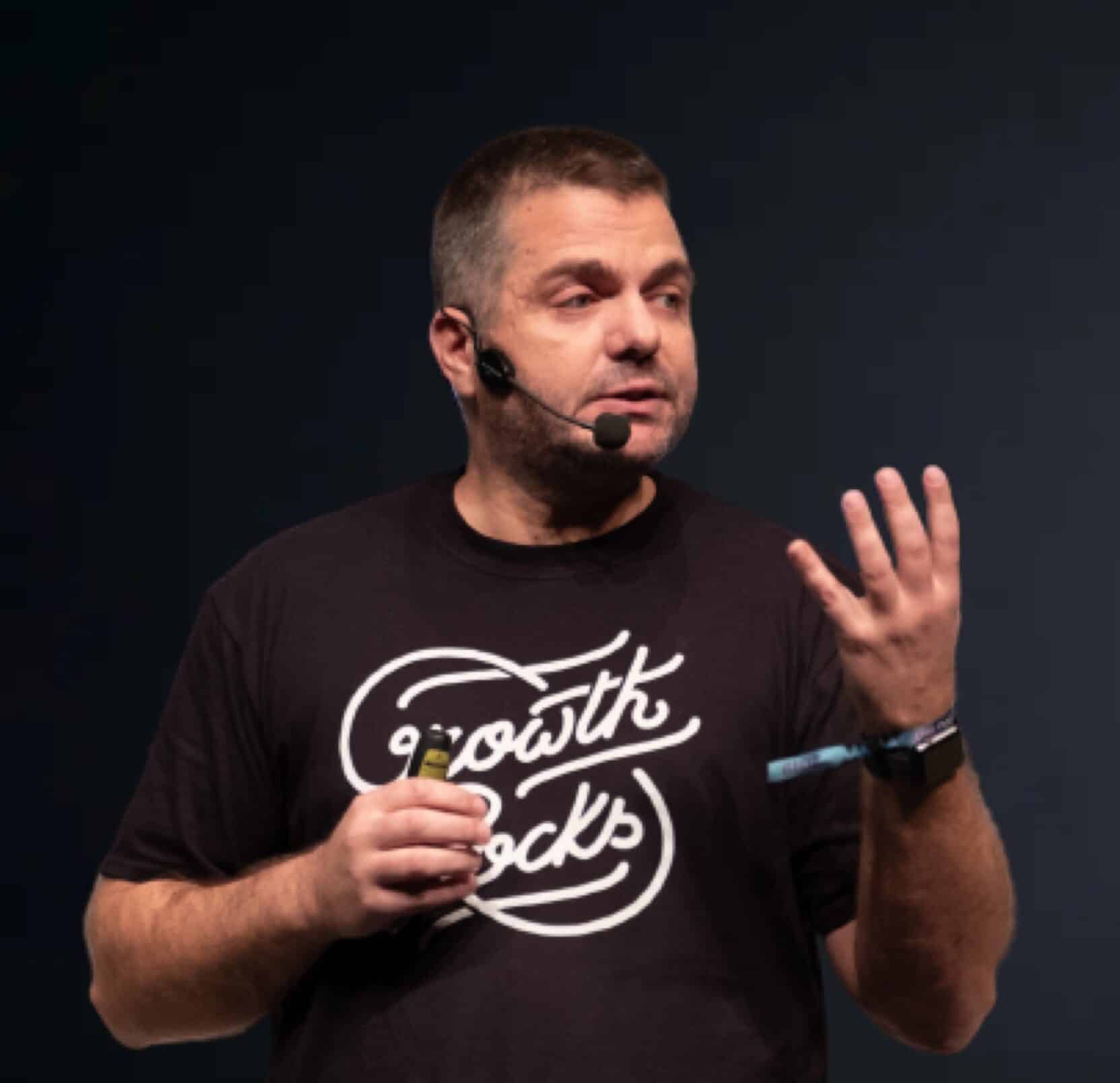
Theodore has 20 years of experience running successful and profitable software products. In his free time, he coaches and consults startups. His career includes managerial posts for companies in the UK and abroad, and he has significant skills in intrapreneurship and entrepreneurship.
